Why has the property survived in pristine condition to this day? Its survival is a direct result of the local culture and traditions.
Taboos
A tradition of taboos
The island of Okinoshima itself is the object within which the deity dwells. Therefore it is protected by strict taboos. First, there is the taboo that prohibits visitors to the island from speaking of anything they have witnessed there. Therefore not much is widely known about the island, and it has been preserved much as it was in ancient times.
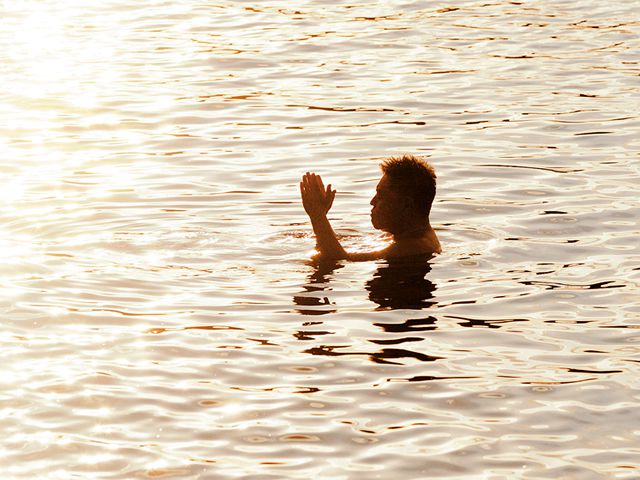
Fishermen protectors
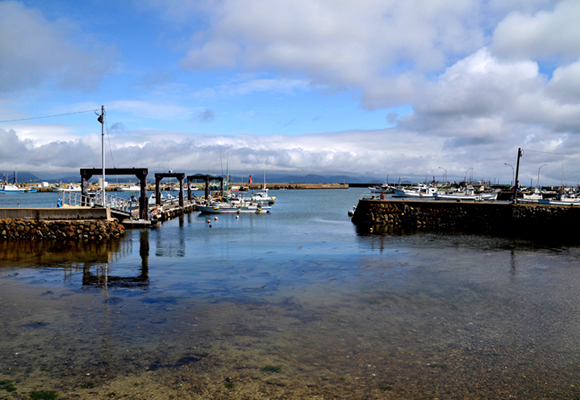
The fishermen of Oshima are the ones who have preserved Okinoshima to this day. For the fishermen of Oshima, Okinoshima has always been an abundant fishing ground. But fishing around Okinoshima, with its high waves, holds many dangers. There is one fixed point of reference, however, that the fishermen have collectively decided upon. "We call ourselves the Friends of Okinoshima. I am the oldest one," says veteran fisherman Ueno Yoshimi. The Friends of Okinoshima is a group composed of fishermen who are affiliated with the Oshima fishery cooperative, but it is not open to everyone. A person is not admitted unless other fishermen in the group observe that he possesses a high level of ability in fishing and handling a boat, and deem that he is of good character.
On clear days the Friends of Okinoshima present the largest fish of the catch as an offering to the deity at the shrine, and never fail to give thanks for the deity's protection each day.
It would be out of the question for them to take anything from the island. The fishermen have said they would refrain even from taking a pine branch that was floating in the ocean."From childhood we hear that you can be cursed if you do what is prohibited," one said, "or speak of anything that occurs there."The friends of Okinoshima believe that the sea that surrounds the island is a sacred precinct. It goes without saying that they express gratitude for the blessings they receive from this sacred maritime realm.
Women and Okinoshima
For the wives of the fishermen of Oshima, the Okinoshima tradition is complex.
Their husbands go there to fish, but because of the taboo against speaking of anything that occurs there, they never speak of it and cannot find out anything about it.
There are rumors of great treasure on the island, but they cannot ask their husbands anything about it.
It is not that they have no connection with the island, however. For example, when they receive news of a death, they will not attend the wake or funeral until their husbands return from fishing at Okinoshima.
Even if it is a close relative, all they have to say is, "My husband is fishing at Okinoshima," and immediately the situation is understood. Brides who marry into families in this community are often confused by these peculiar traditions, but these customs have been passed down within the familie of local fishermen for many years.
Though they might not seem compatible with life in the modern world, the women say that they would rather abide by them than risk having anything happen to their husbands.
The work of the fishermen exposes them to many physical risks. More than a few fishermen have reported that in dangerous situations when they prayed to the deity for help, they were miraculously saved.
When the wives hear this, they think, "So it is true, the deity is watching over my husband." And so they have firmly adhered to the tradition of not speaking of anything that occurs on the island. This is Okinoshima through the eyes of the wives of Oshima fishermen.
Heirs of the faith
Munakata Taisha and its parishioners
Ujiko are shrine parishioners, the worshippers under the protection of a local tutelary deity. Deep faith in the deity bonds the members of these groups together. The following episode concerns the ujiko of Munakata Taisha. In 1937 there was talk of constructing a military fort on Okinoshima, but the shrine parishioners submitted a written report requesting that the plan be halted. It stated that to utilize the shrine precinct for military purposes would go against the wishes of the deity. One of the shrine parishioners sent a telegram to the head priest that stated: "Risk your life to protect Okinoshima." After that, the priests submitted an official petition. The former head of the shrine parishioner youth group, Kobayashi Masakatsu, said that the shrine parishioner youth group were taking part in cleaning at Okitsu-miya and the Takamiya Kannabi Festival at the Autumn Festival, and they wanted to plan the revitalization of the local community by the festivals. Mr. Kobayashi went on to say that it would be the same with the activities related with the World Heritage: "This is the pride of the region. I think it is wonderful that the place we have cared for ourselves for so long should now be recognized as a World Heritage Site."
Festivals
The two main festivals of Munakata Taisha were the Satsuki festival in May, and the Hojo-e (lit. "life-saving") ceremony in August. The Hojo-e ceremony came to be held from October 1st to the 3rd each year after World War II. Now known as the Grand Autumn Festival, it is the most important Shinto ritual that Munakata Taisha conducts each year. In the Miare Festival, which occurs at the start of the Grand Autumn Festival, special boats carrying portable shrines, one dedicated to the deity Tagorihime-no-kami of Okitsu-miya and the other to Tagitsuhime-no-kami of Nakatsu-miya, transfer the shrines by sea from Oshima to the Konominato harbor in the mainland, where their sister Ichikishimahime-no-kami of Hetsu-miya awaits. In this way the three female deities come together once a year at Hetsu-miya. The group of fishing boats advancing on the Genkai Sea, flying their banners that indicate a big catch, is a magnificent sight, and this is a "sea" ritual that clearly bolsters the reputation of the three female deities of Munakata for governing maritime safety. At the same time, the boats carrying the portable shrines and their attendant boats are all fishing vessels from the so-called "seven ports of Munkata", and this event is also a festival for the people of the Munakata region. On the last day of the Grand Autumn Festival, the Kannabi Festival is held at Takamiya Saijo to express gratitude to the three female deities that the grand festival has been safely carried out. On that day, many spectators turn out to witness this mysterious Shinto ritual.
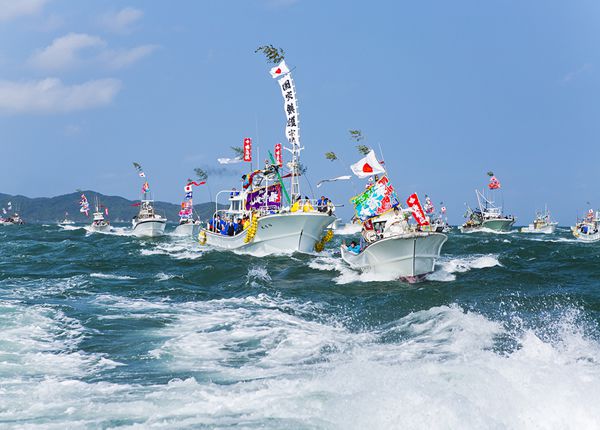
The mounded tomb group and the local community
Preserving local mounded tombs for future generations
There are two reasons that the mounded tomb group and its surrounding landscape are well preserved.
The first of these factors is rumors. Local people will say things like "Someone got close to one of the tombs and he ran a high fever for a month," or they will say that the "tomb wind" will make you sick.
These statements reflect a fear of the unknown, and may also have to do with our predecessors' warnings not to infringe upon carefully preserved sacred areas.
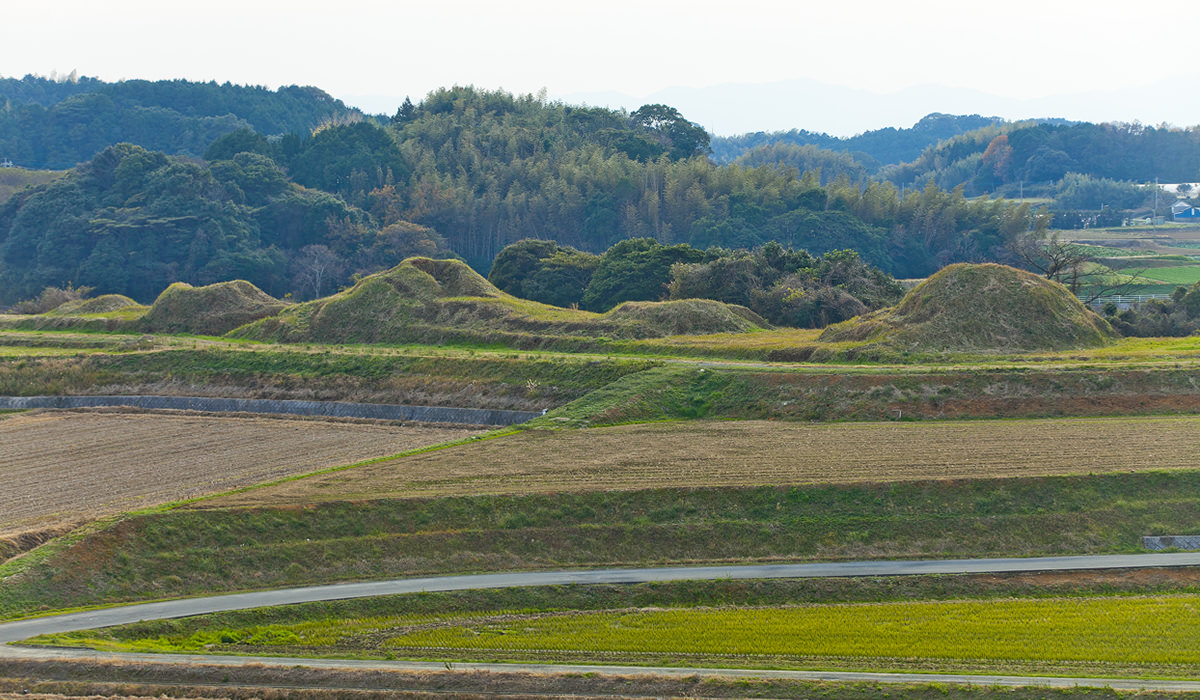
The other reason is the efforts of the local people.
People who live in the Nuyama district cannot help but love the local landscape with its mounded tombs.
Each person has his or her favorite view of the tombs. One may say the best view is from the top of that mountain, while another says that sunset is the most beautiful from this or that spot.
Masuda Misako of the Munakata Riding Club planned to take visitors around to sightseeing spots in Fukuma and Tsuyazaki in a horse-drawn wagon.
"The relaxed pace of the carriage and the landscape of the mounded tombs go very well together," she said.
She says that she would like to leave this tomb landscape for posterity to future generations.
Mounded Tomb Group and Regional Activities
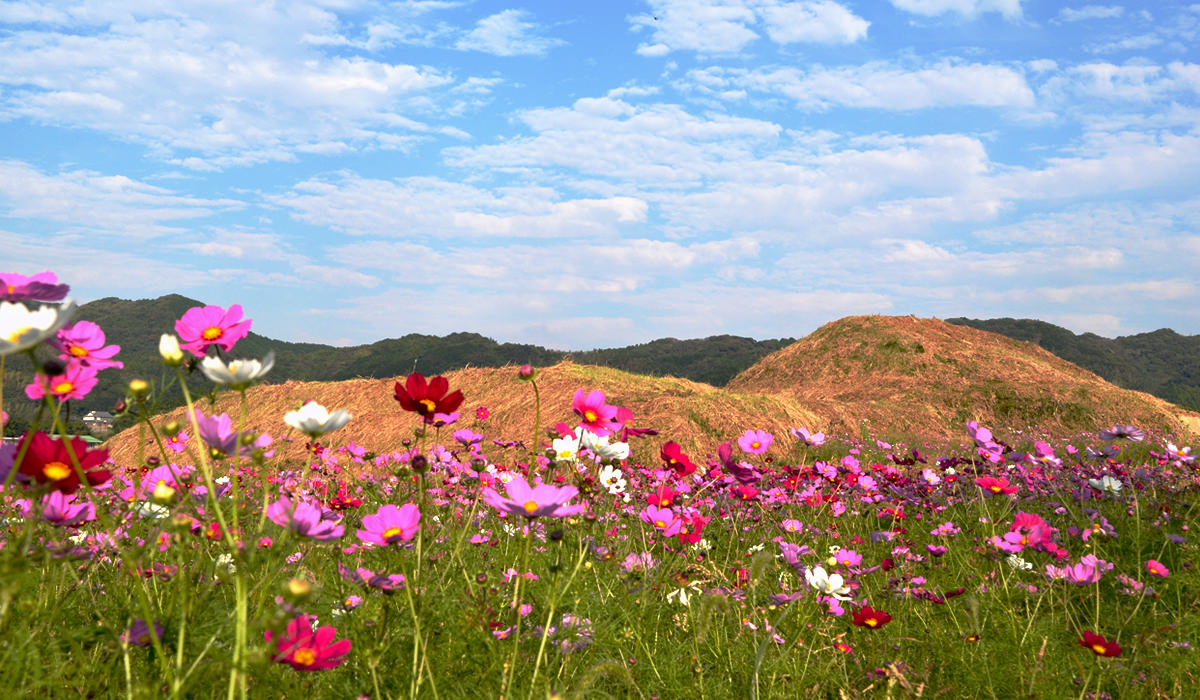
From the fifth century, when the Shimbaru-Nuyama Mounded Tomb Group was built, until the seventeenth century, a large sea inlet opened out near the plateau upon which the mounded tomb is situated.
Later most of that land was reclaimed through drainage and then used for agriculture and salt flats, and this is how it still looks today.
The mounded tomb group is adjacent to nearby farmland, where people pursue their daily activities while also taking great care to preserve the nearby tombs. Local people periodically mow the grass so that the actual form of each tomb is visible.
In addition, there have been initiatives to plant cosmos on the surrounding unused farmland and to convene other events that help people to feel a sense of belonging and ownership toward the mounded tombs.

